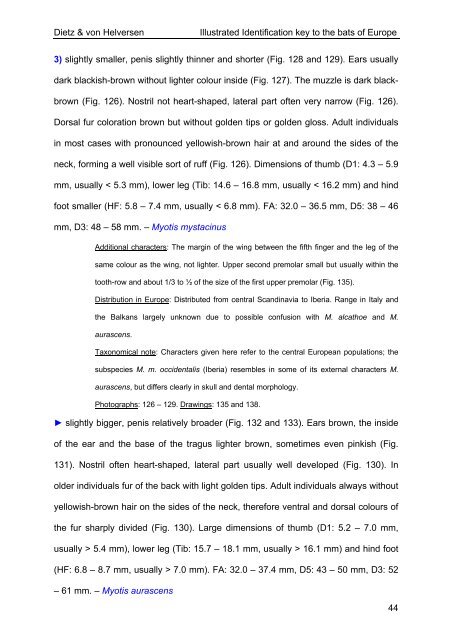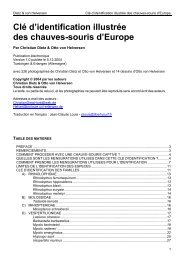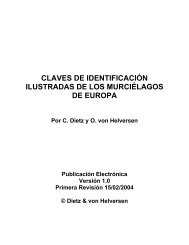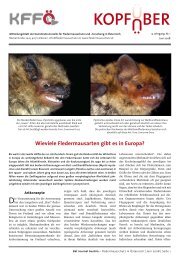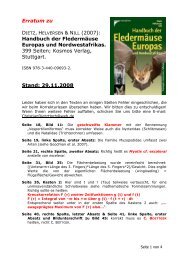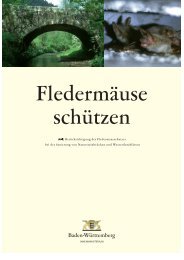Dietz & von Helversen Illustrated Identification key to the bats of ...
Dietz & von Helversen Illustrated Identification key to the bats of ...
Dietz & von Helversen Illustrated Identification key to the bats of ...
Create successful ePaper yourself
Turn your PDF publications into a flip-book with our unique Google optimized e-Paper software.
<strong>Dietz</strong> & <strong>von</strong> <strong>Helversen</strong><strong>Illustrated</strong> <strong>Identification</strong> <strong>key</strong> <strong>to</strong> <strong>the</strong> <strong>bats</strong> <strong>of</strong> Europe3) slightly smaller, penis slightly thinner and shorter (Fig. 128 and 129). Ears usuallydark blackish-brown without lighter colour inside (Fig. 127). The muzzle is dark blackbrown(Fig. 126). Nostril not heart-shaped, lateral part <strong>of</strong>ten very narrow (Fig. 126).Dorsal fur coloration brown but without golden tips or golden gloss. Adult individualsin most cases with pronounced yellowish-brown hair at and around <strong>the</strong> sides <strong>of</strong> <strong>the</strong>neck, forming a well visible sort <strong>of</strong> ruff (Fig. 126). Dimensions <strong>of</strong> thumb (D1: 4.3 – 5.9mm, usually < 5.3 mm), lower leg (Tib: 14.6 – 16.8 mm, usually < 16.2 mm) and hindfoot smaller (HF: 5.8 – 7.4 mm, usually < 6.8 mm). FA: 32.0 – 36.5 mm, D5: 38 – 46mm, D3: 48 – 58 mm. – Myotis mystacinusAdditional characters: The margin <strong>of</strong> <strong>the</strong> wing between <strong>the</strong> fifth finger and <strong>the</strong> leg <strong>of</strong> <strong>the</strong>same colour as <strong>the</strong> wing, not lighter. Upper second premolar small but usually within <strong>the</strong><strong>to</strong>oth-row and about 1/3 <strong>to</strong> ½ <strong>of</strong> <strong>the</strong> size <strong>of</strong> <strong>the</strong> first upper premolar (Fig. 135).Distribution in Europe: Distributed from central Scandinavia <strong>to</strong> Iberia. Range in Italy and<strong>the</strong> Balkans largely unknown due <strong>to</strong> possible confusion with M. alcathoe and M.aurascens.Taxonomical note: Characters given here refer <strong>to</strong> <strong>the</strong> central European populations; <strong>the</strong>subspecies M. m. occidentalis (Iberia) resembles in some <strong>of</strong> its external characters M.aurascens, but differs clearly in skull and dental morphology.Pho<strong>to</strong>graphs: 126 – 129. Drawings: 135 and 138.► slightly bigger, penis relatively broader (Fig. 132 and 133). Ears brown, <strong>the</strong> inside<strong>of</strong> <strong>the</strong> ear and <strong>the</strong> base <strong>of</strong> <strong>the</strong> tragus lighter brown, sometimes even pinkish (Fig.131). Nostril <strong>of</strong>ten heart-shaped, lateral part usually well developed (Fig. 130). Inolder individuals fur <strong>of</strong> <strong>the</strong> back with light golden tips. Adult individuals always withoutyellowish-brown hair on <strong>the</strong> sides <strong>of</strong> <strong>the</strong> neck, <strong>the</strong>refore ventral and dorsal colours <strong>of</strong><strong>the</strong> fur sharply divided (Fig. 130). Large dimensions <strong>of</strong> thumb (D1: 5.2 – 7.0 mm,usually > 5.4 mm), lower leg (Tib: 15.7 – 18.1 mm, usually > 16.1 mm) and hind foot(HF: 6.8 – 8.7 mm, usually > 7.0 mm). FA: 32.0 – 37.4 mm, D5: 43 – 50 mm, D3: 52– 61 mm. – Myotis aurascens44


